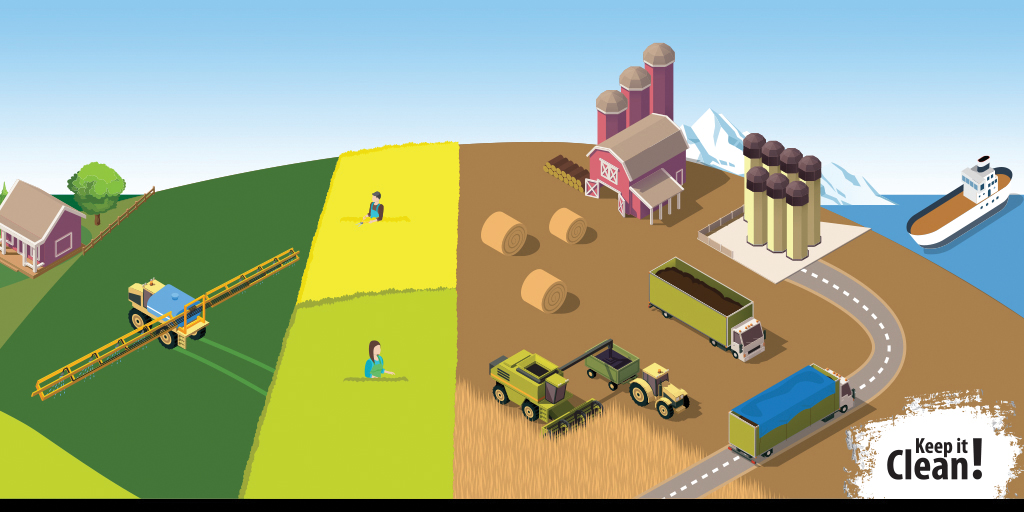KEEP IT CLEAN!
BY BRENNA MAHONEY
Throughout 2019, Canadian agriculture has been faced with a variety of market access concerns with respect to China, Peru, Vietnam, Italy and India. It seems every month there is a new concern or even a market closure. This is why it is critical the entire value chain, including Canadian farmers, works together to keep up with the newest information on what impacts markets.
To best share information in a simple and coordinated way, the Barley Council of Canada, the Canola Council of Canada, Cereals Canada, the Prairie Oat Growers Association and Pulse Canada have joined forces on an important cross-commodity initiative called Keep it Clean!
Through the program, partner groups communicate a clear and consistent message to farmers about on-farm practices that will help reduce market risk. As certain market access issues relate directly to on-farm pesticide usage and residues, it is critical farmers are aware of the vital role they play to preserve markets.
FACING SCRUTINY
Canada’s customers know it for providing clean, consistent, quality products, yet the country still experiences scrutiny. For example, one grain safety aspect of growing concern is pesticide residues. As a result, grain shipments are being scrutinized at ever-increasing levels of rigour in the parts per billion or even parts per trillion range.
Agricultural exports must meet the standards set by importing countries, including tolerances for pesticide residues. In export-dependent nations such as Canada, all parts of the industry must pay close attention to these standards as crop protection technology evolves. This includes addressing market access issues and other potential problems before a new product is introduced or before a new use is added to a label.
FIVE SIMPLE TIPS
At the farm level, farmers are encouraged to follow these five simple tips to ensure harvested crops meet the requirements of domestic and international customers.
1. Use acceptable pesticides only
Apply pesticides registered for use in Canada and that won’t create trade concerns. Talk to your grain buyer to ensure the products used are acceptable to both domestic and export customers.
2. Always read and follow the label
Follow the label for rate, timing and pre-harvest interval. Applying pesticides or desiccants without following label directions, or at the wrong time, may result in unacceptable residues. For example, applying pre-harvest glyphosate too early, such as when seed moisture content is 30 per cent or above, can result in higher than acceptable residue levels.
3. Grow disease-resistant varieties and use practices that reduce infection
Crop diseases such as blackleg in canola and Fusarium head blight in cereals can cause yield and quality losses, impact profitability and may create market risk. Follow best practices and choose disease-resistant varieties, rotate crops and actively scout for signs of disease.
4. Properly store your crop
Proper storage helps maintain crop quality and keeps it free of harmful cross contaminants. For example, canola must never be stored in malathion-treated bins as residue can linger for months and transfer to the seed. Clean bins thoroughly with approved bin treatments when necessary and prior to storing your crop. Also condition crops to moisture and temperature levels safe for long-term storage.
5. Deliver what you declare
Signing the declaration of eligibility affidavit at the elevator is a legal assertion your crop is the variety and/or class you have designated. If your grain could contain residues of any crop input product specified in the declaration, this must be noted. It is a legally binding document and incorrect information can be traced to the farm.
PROTECTING CANADA’S BRAND
Canada has a strong reputation for consistently delivering safe, high-quality grain to our customers. Our farmers have developed this brand over many years and the Canadian grain industry depends on it to access world markets. From crop developers to exporters and processors, it’s the responsibility of every member of the value chain to preserve this hard-won recognition. Working together, we can grow the Canadian brand, preserve high-value markets and open new doors for Canadian production.
For more information on the Keep it Clean! program, including timely farmer advisories and useful resources for canola, cereal and pulse growers, visit
keepingitclean.ca.







Comments